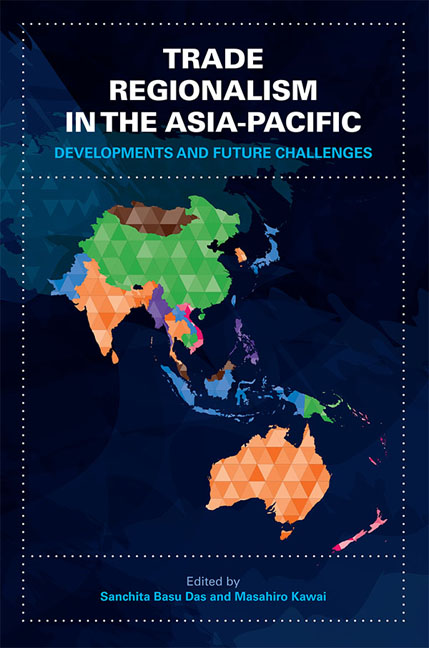135 results in Lectures, Workshops, and Proceedings of International Conferences

The South China Sea Dispute
- Navigating Diplomatic and Strategic Tensions
-
- Published by:
- ISEAS–Yusof Ishak Institute
- Published online:
- 19 May 2017
- Print publication:
- 23 May 2016

Buddhist Dynamics in Premodern and Early Modern Southeast Asia
-
- Published by:
- ISEAS–Yusof Ishak Institute
- Published online:
- 19 May 2017
- Print publication:
- 06 July 2015

Outward Foreign Direct Investment in ASEAN
-
- Published by:
- ISEAS–Yusof Ishak Institute
- Published online:
- 19 May 2017
- Print publication:
- 14 February 2017

Trade Regionalism in the Asia-Pacific
- Developments and Future Challenges
-
- Published by:
- ISEAS–Yusof Ishak Institute
- Published online:
- 05 July 2016
- Print publication:
- 11 April 2016

Globalization and its Counter-Forces in Southeast Asia
-
- Published by:
- ISEAS–Yusof Ishak Institute
- Published online:
- 21 October 2015
- Print publication:
- 29 February 2008

Poverty and Global Recession in Southeast Asia
-
- Published by:
- ISEAS–Yusof Ishak Institute
- Published online:
- 21 October 2015
- Print publication:
- 30 November 2011

Early Interactions between South and Southeast Asia
- Reflections on Cross-Cultural Exchange
-
- Published by:
- ISEAS–Yusof Ishak Institute
- Published online:
- 21 October 2015
- Print publication:
- 10 November 2011

Religious Diversity in Singapore
-
- Published by:
- ISEAS–Yusof Ishak Institute
- Published online:
- 21 October 2015
- Print publication:
- 31 July 2008

Rising India and Indian Communities in East Asia
-
- Published by:
- ISEAS–Yusof Ishak Institute
- Published online:
- 21 October 2015
- Print publication:
- 22 September 2008

Myanmar's Long Road to National Reconciliation
-
- Published by:
- ISEAS–Yusof Ishak Institute
- Published online:
- 21 October 2015
- Print publication:
- 29 June 2006

Myanmar
- Beyond Politics to Societal Imperatives
-
- Published by:
- ISEAS–Yusof Ishak Institute
- Published online:
- 21 October 2015
- Print publication:
- 17 June 2005

ASEAN-EEC Economic Relations
-
- Published by:
- ISEAS–Yusof Ishak Institute
- Published online:
- 21 October 2015
- Print publication:
- 31 December 1981

Portuguese and Luso-Asian Legacies in Southeast Asia, 1511-2011, vol. 2
- Culture and Identity in the Luso-Asian World: Tenacities & Plasticities
-
- Published by:
- ISEAS–Yusof Ishak Institute
- Published online:
- 21 October 2015
- Print publication:
- 11 April 2012

Fiscal System and Practices in ASEAN
- Trends, Impact and Evaluation
-
- Published by:
- ISEAS–Yusof Ishak Institute
- Published online:
- 21 October 2015
- Print publication:
- 01 January 1989

Legacies of World War II in South and East Asia
-
- Published by:
- ISEAS–Yusof Ishak Institute
- Published online:
- 21 October 2015
- Print publication:
- 09 October 2007

Labour Mobility in the Asia-Pacific Region
- Dynamics, Issues and a New APEC Agenda
-
- Published by:
- ISEAS–Yusof Ishak Institute
- Published online:
- 21 October 2015
- Print publication:
- 13 November 2008

Gender and Ageing
- Southeast Asian Perspectives
-
- Published by:
- ISEAS–Yusof Ishak Institute
- Published online:
- 21 October 2015
- Print publication:
- 20 August 2014

Developing Bond Markets in APEC
- Toward Greater Public-Private Sector Regional Partnership
-
- Published by:
- ISEAS–Yusof Ishak Institute
- Published online:
- 21 October 2015
- Print publication:
- 31 August 2005

Whither the Philippines in the 21st Century?
-
- Published by:
- ISEAS–Yusof Ishak Institute
- Published online:
- 21 October 2015
- Print publication:
- 23 November 2007

ASEAN-South Asia Economic Relations
-
- Published by:
- ISEAS–Yusof Ishak Institute
- Published online:
- 21 October 2015
- Print publication:
- 01 January 1985

